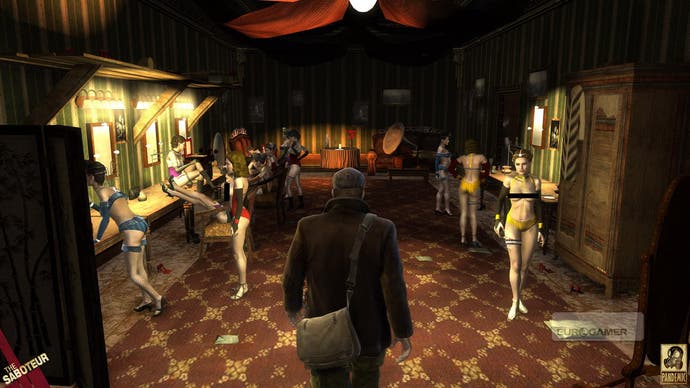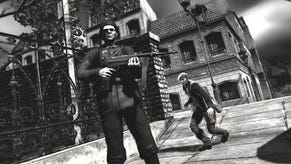The Saboteur
Resistance is fertile.
Deep in the Los Angeles branch of Electronic Arts there is an office where developers fear to tread. And in that dark, fearful room sits EA's vice president of in-game boob representation. It was here that Pandemic must have been ushered when Saboteur was in the planning stages. They would have sat in front of this impassive and unreadable man, and explained what they wanted to do. Create five square kilometres of Nazi-occupied France, rewrite history so that an Irish racing driver kick-started the Gallic resistance, adopt a beautiful art design in which German occupied areas are rendered in black and white with patches of primary colour shining through in vibrant Sin City style... all the good stuff. Then the vice president of in-game boob representation would have lent heavily on his desk, rested his chin on his hands, and shut his eyes as he made his decision. "Your game..." he'd begin, pausing for dramatic effect. "... must have boobs." As so it was decreed, and as so it became form.
I'm being facetious of course. There is no such post within EA. Just an in-built fear that slightly off-kilter settings won't appeal to teenage boys (see also: The Godfather Part 2), and the distant chorus of worried executives pointing at God of War and yelping like sealions. So it is then that in The Saboteur your first base of operations is a knocking shop called Belle de Nuit, and that your initial accomplice in resistance is an upper-class Brit called Skylar who's a bottomless pit of innuendo. Subtle it ain't. Genuinely though, when given a play the game does raise its head above this - while even the most prurient of gamers would be hard-pressed to deny that the seedy underbelly of The Saboteur's fledgling resistance does give it a feeling of Rick's Café in Casablanca or the Kit Kat club in Cabaret. Albeit with markedly more exposed flesh.
The Saboteur's hero is a chap called Sean Devlin, a racing driver caught up in bad Nazi business after a race-gone-wrong in Germany. Very loosely based on real-life driver and resistance hero William Grover Williams, he's a likeable Irishman with lines like "You tell Bishop to go and shite" and an incandescent hatred for Nazis. He hates those guys not only because of their dubious morals but also because the game opens with his best mate dead at their hands, and him tied up and captured by evil car and arms manufacturer the Doppelzieg - who, again, are very loosely based on what the Mercedes corporation got up to back in the 1940s.

As the game proper begins, then, Sean escapes from the Doppelzieg factory - introducing you in turn to the frenetic machinegun spray combat and Devlin's notable climbing prowess. You can scramble over a remarkable number of surfaces, and as you make your way up the outside of the building and past the dark, forbidding company logos and swastikas, any lingering trace of scepticism over The Saboteur's stark art-style evaporates. By the time you've stolen a car and are gunning back towards the French border, ploughing through German roadblocks, driving sidecar-motorbikes off the road and watching your boot disappear in a mess of bullet-holes, a real taste of Indiana Jones has kicked in. There are Nazis everywhere, many of them crushed beneath your wheels admittedly, but they're not all after Devlin. The invasion of France has kicked off, and with it the green and lush fields that you will have seen in the game's opening sequences have become coated with a dreary yet beautiful mottled grey.









